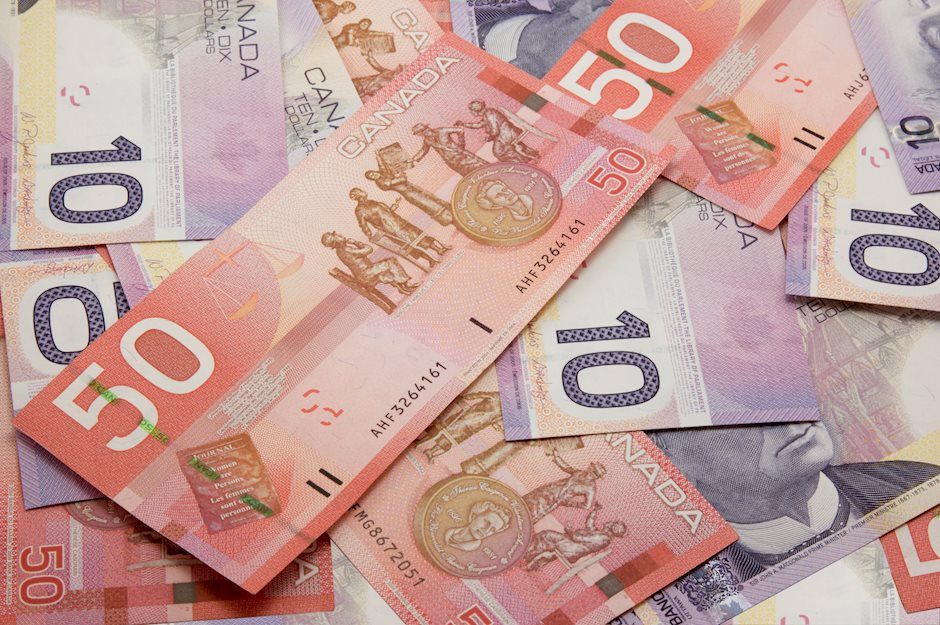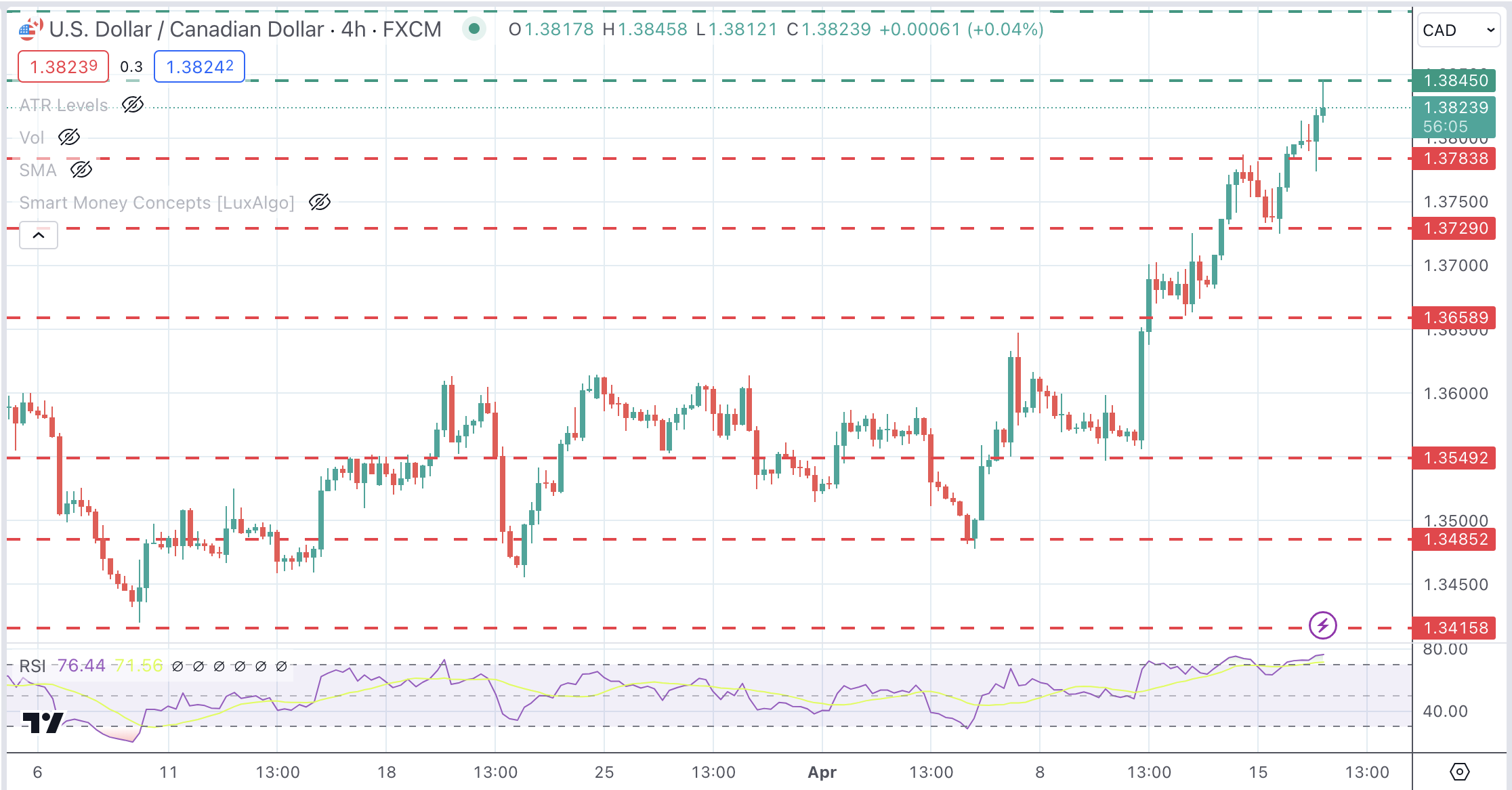Created
: 2024.04.17














![]() 2024.04.17 01:07
2024.04.17 01:07
The Canadian Dollar (CAD) is going through a sharp depreciation against a stronger Greenback on Tuesday, and the mixed Canadian Consumer Prices Index (CPI) has failed to provide any significant support. Consumer inflation accelerated in March although the Core Bank of Canada CPI rose at a slower pace than in the previous month.
These figures come in line with cooling inflationary trends last seen at the Bank of Canada's most recent monetary policy meeting, which would allow them to start cutting rates in June. This explains the negative impact on the Canadian Dollar vis-à-vis the Greenback.
Later Tuesday, BoC Governor Tiff Macklem and Federal Reserve (Fed) Chair Jerome Powell are expected to take part in a panel discussion about the Canadian economy in Washington. Any comments about the monetary policy plans of their respective banks are likely to be analyzed with particular interest.
The table below shows the percentage change of Canadian Dollar (CAD) against listed major currencies this week. Canadian Dollar was the weakest against the Swiss Franc.
| USD | EUR | GBP | CAD | AUD | JPY | NZD | CHF | |
| USD | 0.20% | 0.22% | 0.48% | 1.03% | 0.83% | 1.00% | -0.10% | |
| EUR | -0.19% | 0.02% | 0.26% | 0.83% | 0.63% | 0.81% | -0.32% | |
| GBP | -0.21% | -0.02% | 0.27% | 0.82% | 0.62% | 0.79% | -0.32% | |
| CAD | -0.48% | -0.29% | -0.27% | 0.56% | 0.35% | 0.52% | -0.60% | |
| AUD | -1.05% | -0.85% | -0.84% | -0.56% | -0.21% | -0.03% | -1.16% | |
| JPY | -0.82% | -0.61% | -0.58% | -0.35% | 0.20% | 0.23% | -0.94% | |
| NZD | -0.99% | -0.84% | -0.82% | -0.52% | 0.03% | -0.17% | -1.12% | |
| CHF | 0.12% | 0.31% | 0.34% | 0.60% | 1.15% | 0.95% | 1.12% |
The heat map shows percentage changes of major currencies against each other. The base currency is picked from the left column, while the quote currency is picked from the top row. For example, if you pick the Euro from the left column and move along the horizontal line to the Japanese Yen, the percentage change displayed in the box will represent EUR (base)/JPY (quote).
The US Dollar seems unstoppable. The pair has rallied non-stop during the last six trading days, appreciating nearly 2%. RSI levels are at overbought territory, although with no sign of a reversal in sight.
Bulls have hit resistance at the 1.3845 area, and these conditions suggest the possibility of a bearish correction. In that case, 1.3785 and 1.3730 are likely to provide support. On the upside, above 1.3845, the next target is the November 2023 high at 1.3900.

Central Banks have a key mandate which is making sure that there is price stability in a country or region. Economies are constantly facing inflation or deflation when prices for certain goods and services are fluctuating. Constant rising prices for the same goods means inflation, constant lowered prices for the same goods means deflation. It is the task of the central bank to keep the demand in line by tweaking its policy rate. For the biggest central banks like the US Federal Reserve (Fed), the European Central Bank (ECB) or the Bank of England (BoE), the mandate is to keep inflation close to 2%.
A central bank has one important tool at its disposal to get inflation higher or lower, and that is by tweaking its benchmark policy rate, commonly known as interest rate. On pre-communicated moments, the central bank will issue a statement with its policy rate and provide additional reasoning on why it is either remaining or changing (cutting or hiking) it. Local banks will adjust their savings and lending rates accordingly, which in turn will make it either harder or easier for people to earn on their savings or for companies to take out loans and make investments in their businesses. When the central bank hikes interest rates substantially, this is called monetary tightening. When it is cutting its benchmark rate, it is called monetary easing.
A central bank is often politically independent. Members of the central bank policy board are passing through a series of panels and hearings before being appointed to a policy board seat. Each member in that board often has a certain conviction on how the central bank should control inflation and the subsequent monetary policy. Members that want a very loose monetary policy, with low rates and cheap lending, to boost the economy substantially while being content to see inflation slightly above 2%, are called 'doves'. Members that rather want to see higher rates to reward savings and want to keep a lit on inflation at all time are called 'hawks' and will not rest until inflation is at or just below 2%.
Normally, there is a chairman or president who leads each meeting, needs to create a consensus between the hawks or doves and has his or her final say when it would come down to a vote split to avoid a 50-50 tie on whether the current policy should be adjusted. The chairman will deliver speeches which often can be followed live, where the current monetary stance and outlook is being communicated. A central bank will try to push forward its monetary policy without triggering violent swings in rates, equities, or its currency. All members of the central bank will channel their stance toward the markets in advance of a policy meeting event. A few days before a policy meeting takes place until the new policy has been communicated, members are forbidden to talk publicly. This is called the blackout period.
![]()
Created
: 2024.04.17
![]()
Last updated
: 2024.04.17

FXStreet is a forex information website, delivering market analysis and news articles 24/7.
It features a number of articles contributed by well-known analysts, in addition to the ones by its editorial team.
Founded in 2000 by Francesc Riverola, a Spanish economist, it has grown to become a world-renowned information website.
We hope you find this article useful. Any comments or suggestions will be greatly appreciated.
We are also looking for writers with extensive experience in forex and crypto to join us.
please contact us at [email protected].
Disclaimer:
All information and content provided on this website is provided for informational purposes only and is not intended to solicit any investment. Although all efforts are made in order to ensure that the information is correct, no guarantee is provided for the accuracy of any content on this website. Any decision made shall be the responsibility of the investor and Myforex does not take any responsibility whatsoever regarding the use of any information provided herein.
The content provided on this website belongs to Myforex and, where stated, the relevant licensors. All rights are reserved by Myforex and the relevant licensors, and no content of this website, whether in full or in part, shall be copied or displayed elsewhere without the explicit written permission of the relevant copyright holder. If you wish to use any part of the content provided on this website, please ensure that you contact Myforex.
Myforex uses cookies to improve the convenience and functionality of this website. This website may include cookies not only by us but also by third parties (advertisers, log analysts, etc.) for the purpose of tracking the activities of users. Cookie policy